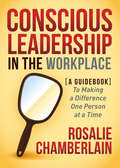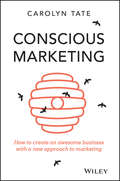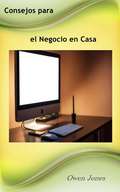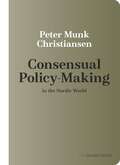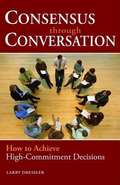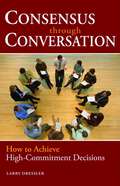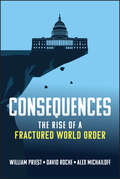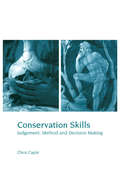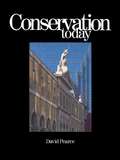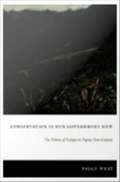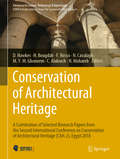- Table View
- List View
Conscious Dwelling: For Transdisciplinary Cityscapes (Springer Series in Design and Innovation #20)
by Anna AnzaniThrough a transdisciplinary perspective, this book examines the complex urban dimension, in front of increasing density, soil consumption, abandoned places, and the recent pandemic which proved megacities particularly inadequate to provide healthy psychophysical conditions. Assuming bodily and emotional comfort as a reference horizon, it tends to inspire the design research overcoming a paradoxical binary logic that separates public and private, outside and inside, culture and nature, mind and places. The first part of the work explores built spaces and addresses sustainable strategies not only to overcome an ecologic and systemic crisis but also to improve places liveability in our contemporary city. The second part deals with our perception of aesthetic spaces, welcoming the stimuli coming from neuro-aesthetics studies on affordances and atmosphere and encouraging the intersection between interior architecture and design culture and arts. The third part examines relational spaces and how they influence human behaviour, starting from psychological, anthropological, and philosophical perspectives. The book benefits scholars and practitioners interested in interior architecture and design, as well as researchers involved in the relationship between people and places. The new challenge posed by the recent pandemic requires more than ever to rely on consciousness, culture and creativity to increase the intelligence of our surroundings, allowing our sense of belonging and improving our personal and mutual well-being.
Conscious Leadership in the Workplace: A Guidebook to Making a Difference One Person at a Time
by Rosalie ChamberlainConscious Leadership in the Workplace is a guidebook for individuals and leaders to lead more effectively and to support and create dynamic, successful, and inclusive environments, by taking a deeper dive into the importance of addressing individual unconscious bias. Unconscious bias can impact the diversity of the workforce and the success of an organization in a global marketplace. Conscious Leadership in the Workplace gives helpful tips for leaders to consider how they currently lead, address their unconscious biases and behaviors, and transform their leadership to effectively lead themselves and others.
Conscious Leadership: Elevating Humanity Through Business
by Carter Phipps John Mackey Steve McintoshFrom Whole Foods CEO John Mackey and his coauthors, a follow-up to groundbreaking bestseller Conscious Capitalism—revealing what it takes to lead a purpose-driven, sustainable business.John Mackey started a movement when he founded Whole Foods, bringing natural, organic food to the masses and not only changing the market, but breaking the mold. Now, for the first time, Conscious Leadership closely explores the vision, virtues, and mindset that have informed Mackey&’s own leadership journey, providing a roadmap for innovative, value-based leadership—in business and in society. Conscious Leadership demystifies strategies that have helped Mackey shepherd Whole Foods through four decades of incredible growth and innovation, including its recent sale to Amazon. Each chapter will challenge you to rethink conventional business wisdom through anecdotes, case studies, profiles of conscious leaders, and innovative techniques for self-development, culminating in an empowering call to action for entrepreneurs and trailblazers—to step up as leaders who see beyond the bottom line.
Conscious Marketing
by Carolyn TateIn the modern economy, businesses must have heart The marketing industry is broken. Consumers are tired of interruption, push, mass media and the manipulation of marketing and advertising generally. They want to deal with honest, ethical companies that have heart and purpose and that care about serving all their stakeholders instead of their pockets. Conscious Marketing proves that marketing can really work if the paradigm is shifted--radically. In Conscious Marketing: How to Create an Awesome Business With a New Approach to Marketing, author Carolyn Tate demonstrates just how beneficial this shift can be. By practising the four tenets of conscious marketing, companies can raise their brand's profile and attract customers for life. The book shows how building a business with a higher-purpose can lead to sustainability, profitability and industry leadership. Conscious marketing works for both multinational corporations and cash-strapped small business alike. In the modern market, a business that does well and contributes to the elevation of humanity and the planet attracts the best customers, employees, suppliers and investors. These people evangelize, and the brand reach expands exponentially further and to a more loyal audience than traditional marketing will ever capture. This concept and other topics in the book include: What's wrong with marketing and why it doesn't work What "conscious" means to the consumer, business, leader and marketer The who, what, why and how of conscious marketing Navigating the shift from traditional to conscious practices The book includes a three-part guide to crafting an actionable plan, including where to find help. Marketing doesn't have to be the budgetary dead weight it has become. It can be fun, human and inspiring for everyone involved, but change requires a deep shift in thinking and behaviour that goes way beyond the transaction or the sale. To stay relevant in the modern economy, businesses must show what's at their core, why they do what they do and why it matters. Conscious Marketing is a comprehensive guide to fixing the problem, with a sustainable solution.
Conscious Money: Living, Creating, and Investing with Your Values for a Sustainable New Prosperity
by Patricia AburdeneWhy not make money and make a difference, too? A revolutionary blueprint for growing wealth, finding fulfillment, and changing the world by living your values. In the emerging era of Conscious Money, we achieve prosperity by tapping into the power of values, consciousness, and sound economic principles. By applying the wisdom of Conscious Money to your personal finances, you can build a foundation for sustainable wealth and true fulfillment. No longer will you need to choose between your core values and your paycheck. Instead you'll expand on-the-job creativity, grow income through conscious practices, and change the world as you: * identify your unique personal values; * break down barriers to financial success; * partner with companies that reflect your values; * express your values through conscious shopping; * tap into higher consciousness at the office; * harness your intuition to clarify financial choices; and * invest in enterprises that honor the planet.
Conscious: The Power of Awareness in Business and Life
by Bob Rosen Emma-Kate SwannConscious is a deeply human approach to personal change Our world is changing faster than our ability to adapt. Ambushed by speed, complexity, and uncertainty, many of us are unprepared for this acceleration. We act on autopilot as new challenges confront us. We are too reactive to problems and miss out on opportunities. We get hijacked by conflicting values and polarizing relationships. We face uncertainty with fear and mistrust. Stress and burnout are pervasive as many of us do not perform up to our potential. Organizations are not adapting well either. Seventy percent of change efforts fail. Slow execution, unrealized growth, unhealthy cultures, and obsession with short-term results undermine long-term success. Inside communities, there is more tension, diminishing trust in our institutions, and a growing inability to solve our most complex social problems. The primary culprit for these maladies is our lack of awareness. Let’s face it: Our current approach to change is running out of steam. And the cost of unaware people is too high to pay. In this age of acceleration, we need a fresh approach to living and leading. CONSCIOUS is our wake-up call – to be aware, awake, and accountable. Nothing is more important than understanding ourselves, our relationships, and our surroundings. Being conscious helps us think deeper, learn faster, and collaborate better. The more conscious we are, the faster we adapt, and the higher performing we become. Conscious is the new smart. As one of the premier global experts on leadership and transformation, Bob Rosen and Healthy Companies have revealed a profound truth about modern-day change: the most successful people, at all levels of society, follow four powerful practices of being conscious: Go Deep – Discover your inner self Think Big – See a world of possibilities Get Real – Be honest and intentional Step Up – Act boldly and responsibly Conscious is your personal roadmap through transformation – helping you adapt and accelerate into the future. To create sustainable change for yourself and your business. Why not be the one with your head lights on while others are driving in the dark?
Consciousness-Based Leadership and Management, Volume 1: Vedic and Other Philosophical Approaches to Oneness and Flourishing (Palgrave Studies in Workplace Spirituality and Fulfillment)
by Anil K. MaheshwariThis two-volume set examines the need for a consciousness-based view of leadership, which emphasizes universal human flourishing, as opposed to a resource-based view, which focuses on sustaining a competitive advantage. This approach is built around three main principles: 1) Paradigm (Consciousness is primary including complementary existence of opposites), 2) Interpersonal (focusing on empathy and compassion), and 3) Individual (experiencing Oneness and expressing creativity). Volume One is divided into three sections. The first section focuses on Consciousness-based approaches to Inclusive, Purposeful, Quantum, and Vedic leadership. The second section focuses on leadership principles from Vedic scriptures such as Ramayana and Vedanta. The third section includes leadership principles from other scriptures such as Buddhism, Confucianism, Daoism, and Thirukural. Aligning leadership practices with the notion of unbounded consciousness, this edited collection will extend the literature on organizational culture, leadership, and sustainability, contributing to solving the grand challenges facing humanity.
Consciousness-Based Leadership and Management, Volume 2: Organizational and Cultural Approaches to Oneness and Flourishing (Palgrave Studies in Workplace Spirituality and Fulfillment)
by Anil K. MaheshwariThis two-volume set examines the need for a consciousness-based view of leadership, which emphasizes universal human flourishing, as opposed to a resource-based view, which focuses on sustaining a competitive advantage. This approach is built around three main principles: 1) Paradigm (Consciousness is primary, including complementary existence of opposites), 2) Social/Interpersonal (focusing on empathy and compassion), and 3) Individual (experiencing Oneness and expressing creativity).Volume Two is divided into two sections. Each section offers a mix of qualitative and quantitative studies. The first section focuses on consciousness-based development of organizational capabilities such as ambidexterity, flow, and work-life balance. The second section is focused on organizational interventions such as reinvention, meaning-making, well-being, and sustainability. Aligning leadership practices with the notion of an unbounded consciousness, this edited collection will extend literature on organizational culture, leadership, and sustainability, contributing to solving the grand challenges facing humanity.
Consejos para el Negocio en Casa (Cómo hacerlo... #27)
by Owen JonesConsejos para el Negocio en Casa Hola y gracias por comprar este libro electrónico llamado "Consejos para el negocio en casa". Espero que esta información te resulte útil, conveniente y rentable. La información en este libro electrónico sobre varios aspectos sobre los negocios en el hogar y las ideas relacionadas está organizada en 16 capítulos de aproximadamente 500-600 palabras cada uno. Espero que este libro le resulte interesante a quienes les gusta trabajar desde casa. Como beneficio adicional, te autorizo para usar este contenido en tu propio sitio web o en tus propios blogs y boletines informativos, aunque es mejor si primero los reescribes con tus propias palabras. También puedes dividir el libro y revender los artículos. De hecho, el único derecho que no tienes es el de revender o regalar el contenido del libro tal como se te entregó. Si tienes algún comentario, déjalo en la compañía en donde compraste este libro y en los lugares donde se puedan encontrar más libros similares. Gracias de nuevo por comprar este libro electronico, Saludos, Owen Jones
Conselhos úteis para a poupança diária
by Jaime VillataQueres poupar dinheiro? Acalma o gasto. Somos uma ameaça!... Quando temos notas na mão… e isto é uma lamentável realidade, por mais que procuremos desculpas para negá-lo. Este proceder é muito palpável quando temos o desejo de poupar dinheiro, mas sempre é uma desculpa dizer que não temos dinheiro suficiente para fazê-lo, é por isso, que se queremos aumentar a nossa capacidade de poupar deveríamos evitar passar tão frequentemente pela caixa de multibanco automática, e já te diremos o porquê. Se o nosso objetivo é poupar, devemos fazer o possível por manter o dinheiro na nossa conta bancária o maior tempo possível, ora bem. Porque é importante manter o dinheiro no banco? A resposta é muito simples, permite-te ter o gasto controlado, há mais ordem e organização. As estatísticas indicam que vamos à caixa multibanco, um pouco mais de uma vez por semana, ainda assim, esta frequência já significa uma diminuição em comparação com anos anteriores Conselhos para evitar que se acabe o dinheiro em efetivo Deves ter bem estipulada a quantidade de dinheiro em efetivo que necessitas, sempre que requeremos o efetivo para algo em especial que nos faz ir à caixa multibanco automática, um segredo é não te desviares desse objetivo. Não devemos gastar o dinheiro que destinámos para um fim, em outra coisa que a maioria das vezes pode ser sem importância. Ainda que quase sempre não temos poder para decidir sobre que notas nos dará o multibanco, as de menor denominação são mais fáceis de manejar, têm muitas vantagens no seu uso e iremos destacá-las mais adiante.
Consensual Policy-making in the Nordic World (Nordic World)
by Peter Munk ChristiansenThis book examines the model developed in the Scandinavian countries for handling labor market relations between employers and employees—a model that has secured flexible and well-functioning labor market relations with comparatively high remuneration in case of sickness or unemployment. Consensual—and comparatively efficient—policies have likewise been pursued in agricultural, industrial, environmental policies, and in many policies related to public services. The preconditions for these policies are strong civil societies, that is, strong capacities for collective mobilization and collective action among groups, relatively strong unitary states, and high levels of generalized trust. The institutional apparatus of these consensual policies has been labeled corporatism. Scandinavian corporatism has implied consent to a norm of affected interests. Groups that are supposedly affected by state policies have access to the processes leading up to political decision-making and are involved in the implementation of policies. This access often has public commissions or committees charged with preparing political decisions and delivering advice, as well as policy implementation committees. Corporatist and consensual policymaking come at a price. The exchange between interest groups (in pursuit of policy influence) and state actors (in pursuit of information and political support from groups) tends to be time-consuming and confined to solutions that are accepted by all actors. Corporatist policies are consequently not very conducive to more radical reforms. After the heyday of corporatist policymaking in the 1970s, all the Scandinavian countries have loosened their corporatist structures to pave the way for reforms.
Consensus Forecasts and Inefficient Information Aggregation
by Christopher CroweA report from the International Monetary Fund.
Consensus Is Not Kumbaya: Lessons In Tough-Minded Leadership
by Rand GolletzWant Success? Discard Hardheadness for Tough Mindedness. No one knows better than Rand Golletz what it takes to transform hard-headed executives into tough-minded leaders. As a coach, he gets executives to: unlock the secrets of personal accountability, think critically in making decisions every day, and develop and sustain profitable business relationships. As an author, he distills the wisdom gleaned from his successful career as an executive, consultant, and coach into tough-minded lessons that stick.Here’s how to gain this wisdom for yourself. Place Consensus is Not Kumbaya on your night table, then read one brief chapter each night before lights-out. From that one digestible lesson, take one relevant action the next day. Do this consistently and things will shift. Guaranteed.
Consensus Modeling to Promote Group Wisdom: Methods and Applications (Contributions to Management Science)
by Jing Wang Zhijiao Du Sumin Yu Xuanhua XuThis book explores the latest theories, methods, and applications of consensus modeling. It proposes a variety of consensus modeling methods for different decision-making contexts, including conflict risk mitigation in group decision-making, integration with the failure mode and effects analysis technique, consideration of over-adjustment and flexible consensus, social network large-group decision-making environments involving multiple consensus costs, and multi-agent collaborative decision-making with consideration of trade-offs between revenue and reputation. In addition, this book discusses the application and implementation process of the proposed consensus modeling techniques in real-world decision-making, including collecting decision data, organizing decision-making groups, controlling the decision-making process, and evaluating the results. We encourage researchers, academics, students, business managers, and policy makers engaged in a variety of real-world decisions characterized by group decision-making (e.g., emergency decisions, public affairs decisions, and major corporate decisions) to pay attention to the proposals presented in the book. This book systematically describes the latest theories, methods, and applications of consensus modeling with a view to providing practical methodological support for corporate decision-making, governmental decision-making, and so on. Special emphasis is placed on the fact that this book can provide students, especially graduate students, with a comprehensive perspective on the study of consensus modeling. For businesses and governments, this book provides methodological support for how to merge inputs from multiple parties to obtain a majority-approved consensus solution (at minimal group cost) and ultimately develop group wisdom.
Consensus Through Conversation: How to Achieve High-Commitment Decisions
by Larry DresslerIt explains how the "leader as brain, employees as body" model is disappearing, as more and more organizations are realizing that sustained change comes from people who are personally committed to a future that they have helped create.
Consensus Through Conversations: How to Achieve High-Commitment Decisions
by Larry DresslerReal organizational change isn't brought about by decree, pressure, permission, or even persuasion. Sustained change comes when people are passionately and personally committed to a future that they have helped to shape. If you want to turn your organization's cynics into owners, give them a voice in the decisions that impact their work. Consensus Through Conversation shows how. Consensus is a cooperative process in which all of a group's members develop and agree to actively support a decision. It's not mere acquiescence--consensus goes several steps beyond, transforming people from resigned instruction-followers to dedicated champions of an idea. Larry Dressler shows you exactly how to prepare for a successful consensus-building process, takes you step-by-step through that process, and offers tips for success and traps to avoid. Throughout, he provides a host of tools and examples that make this an eminently practical and immediately useful guide. Consensus Through Conversation will give you the tools you need to use consensus effectively in your organization. It is a handy, vital reference that you will turn to again and again in your efforts to tackle high stakes issues, make high quality decisions, and build enthusiasm and commitment to action.
Consensus-Oriented Decision-Making
by Tim HartnettConsensus-Oriented Decision-Making combines extensive knowledge of effective communication techniques with deep insight into conflict resolution and group dynamics. This practical step-by-step facilitation guide presents an efficient method any business, government, non-profit, social or community group can use to generate widespread agreement on important decisions with full member participation in an atmosphere of true collaboration.
Consequences of Social Transformation for Economic Theory: Proceedings of the 2022 Euro-Asian Symposium on Economic Theory (EASET), Ekaterinburg, Russia (Springer Proceedings in Business and Economics)
by Vikas Kumar Wei-Bin Zhang Evgeny Kuzmin Yuliya LavrikovaThis book presents selected papers of the Euro-Asian Symposium on Economic Theory, held by the Institute of Economics of the Ural Branch of the Russian Academy of Sciences (Ekaterinburg, Russia) on June 29-30, 2022. The conference aims to promote research and develop effective solutions to urgent challenges in economic theory in the context of stability and uncertainty.The main theme of the 2022 Conference is the "Viability of Economic Theories". The chaos of the modern world forces us to rethink many theoretical positions. Researchers are trying to overcome the contradictions between theory and empiricism through new models, mechanisms and approaches. The challenges of recent social change have led to an adjustment in the perception, interpretation, and use of many concepts, necessitating an updating of these terms. The problems and contradictions identified in the studies will help to reconcile theoretical approaches with practice. The volume covers topics such as sustainable development issues, economic shocks in the history of economic thought, modern economic concepts of identity, theory of organizations under uncertainty, review of economic theories with the "Corona crisis," models of consumer behavior, business cycles, theory of investment, issues of economic growth and market equilibrium, impact of social factors on the sustainability of the economy, etc. Moveover, the volume presents new solutions for the synthesis of mainstream and political economy ideas. These topics will be of great interest to academics, researchers and practitioners.
Consequences: How to Describe How Well Each Alternative Meets Your Objectives
by John S. Hammond Ralph L. Keeney Howard RaiffaThis chapter looks at an important element of effective decision making: assessing frankly the consequences of each potential choice, which will help you identify those that best meet your objectives.
Consequences: The Rise of a Fractured World Order
by David Roche William W. Priest Alex MichailoffAn engrossing and practical discussion of how to deal with contemporary challenges to democracy and civilization. In Consequences: The Rise of a Fractured World Order, William Priest, David Roche, and Alex Michailoff deliver an engaging, timely, and insightful analysis of identifying the sources and challenges facing liberal democracies and their ability to confront autocracies and autocratic behavior. The authors identify and address structural flaws present in both democracies and autocracies. The book explains why the creation and distribution of wealth matters in creating nations where democracy can flourish, and the populace at large can win. Strategies for the creation of wealth (broadly defined) and its equitable distribution combined with the democratic tools that voters, investors, and citizens have available make it more likely those strategies can be deployed. You'll also find: Detailed and accurate discussions of the end of the liberal world order, post-cold war historical shifts, and the challenges that lie ahead. Explorations of the threat to democracy posed by populist politics and philosophies. An analysis of the likelihood of contemporary political actors to reform our economics and politics, and the steps we can take if they fail to do so A startlingly original and eye-opening read for executives, investors, policymakers, and regulators, Consequences is an essential resource for everyone interested in the interplay between politics, economics, and long-term investment outcomes.
Conservation Skills: Judgement, Method and Decision Making
by Chris CapleConservation Skills provides an overview of the issues facing conservators of historic and artistic works. It not only describes the nature of conservation but also provides an ethical framework to which the conservation of objects can be related. Drawing on case studies of well-known objects such as the body of Lindow Man and the Statue of Liberty it addresses the following issues: * perception, judgement and learning * reasons for preserving the past * the nature and history of conservation * conservation ethics * recording, investigating, cleaning objects * stabilisation and restoration * preventive conservation * decision making and responsibilities.
Conservation Tillage in U.S. Agriculture: Environmental, Economic, and Policy Issues
by Noel UriDiscover farming techniques that will decrease soil erosion and costs!Soil erosion from U.S. croplands has long been recognized as a national problem. Conservation Tillage in U.S. Agriculture: Environmental, Economic, and Policy Issues is the first ever complete study of the costs and benefits of using conservation tillage to prevent soil erosion. Designed for professionals working in the areas of soil science, agronomy, economics, environmental studies, and agriculture, this complete study covers everything from machinery and trends in conservation tillage to its adoption to use in regions of the United States.With this in-depth manual, you will examine different types of tillage and the many benefits this practice can ensure, such as improving water quality, increasing organic matter in your soil, sequestering carbon, and providing habitat and food for wildlife. Covering the economic, environmental, and policy issues of this practice, Conservation Tillage in U.S. Agriculture features: the history of conservation tillage case studies on costs and benefits of differing conservation tillage practices with various crops tables and graphs of trends, and case studies concerning the use of different farming methods U.S. Department of Agriculture soil conservation policies how to prevent soil erosion without harming the environment factors affecting conservation tillage, adoption, and use for crops such as peanuts, potatoes, beets, tobacco, and vegetables. With the help of this book, you will measure the benefits and costs of conservation tillage based on profitability and environmental impact and explore the positive and negative environmental consequences that may involve air, land, water, and/or the health and ecological status of wildlife. Conservation Tillage in U.S. Agriculture is a timely and informative look at conservation tillage practices that will help you improve residue management and create better conditions for wildlife and the environment.
Conservation Today: Conservation in Britain since 1975
by David PearceFirst published in 1989. Routledge is an imprint of Taylor & Francis, an informa company.
Conservation is Our Government Now: The Politics of Ecology in Papua New Guinea
by Paige WestA significant contribution to political ecology, Conservation Is Our Government Now is an ethnographic examination of the history and social effects of conservation and development efforts in Papua New Guinea. Drawing on extensive fieldwork conducted over a period of seven years, Paige West focuses on the Crater Mountain Wildlife Management Area, the site of a biodiversity conservation project implemented between 1994 and 1999. She describes the interactions between those who ran the program--mostly ngo workers--and the Gimi people who live in the forests surrounding Crater Mountain. West shows that throughout the project there was a profound disconnect between the goals of the two groups. The ngo workers thought that they would encourage conservation and cultivate development by teaching Gimi to value biodiversity as an economic resource. The villagers expected that in exchange for the land, labor, food, and friendship they offered the conservation workers, they would receive benefits, such as medicine and technology. In the end, the divergent nature of each group's expectations led to disappointment for both. West reveals how every aspect of the Crater Mountain Wildlife Management Area--including ideas of space, place, environment, and society--was socially produced, created by changing configurations of ideas, actions, and material relations not only in Papua New Guinea but also in other locations around the world. Complicating many of the assumptions about nature, culture, and development underlying contemporary conservation efforts, Conservation Is Our Government Now demonstrates the unique capacity of ethnography to illuminate the relationship between the global and the local, between transnational processes and individual lives.
Conservation of Architectural Heritage: A Culmination of Selected Research Papers from the Second International Conference on Conservation of Architectural Heritage (CAH-2), Egypt 2018 (Advances in Science, Technology & Innovation)
by Hocine Bougdah Nabil Mohareb Dean Hawkes Chaham Alalouch Federica Rosso Nicola Cavalagli Mahmoud Yousef M. GhoneemHistory is one of the main aspects that shapes a country’s culture and leaves its traces on the built environment in the form of an architectural heritage. Such a heritage records the existence of humans, their past endeavours and in doing so preserves their cultures and traditions for future generations and contributes to the formation of their identities by acting as an inspiration for their architectural achievements. From this perspective, conservation of architectural heritage becomes important to both current and future architectural endeavours. This book discusses several topics of great importance and relevance to the conservation of worldwide architectural heritage. From historic cities and cultural landscapes to some of the largest archaeological sites in the world, conserving such a legacy is a challenging task that requires commitment, effort and international cooperation that this book proves possible. The book has an abundance of information that undoubtedly covers major areas in the field of architecture heritage. It discusses the challenges faced in the field and demonstrates the importance of such an undertaking to individuals, communities, and cities’ identity all over the world. It also highlights the role of individuals and organizations in the precise and complex process of conserving architectural heritage.

